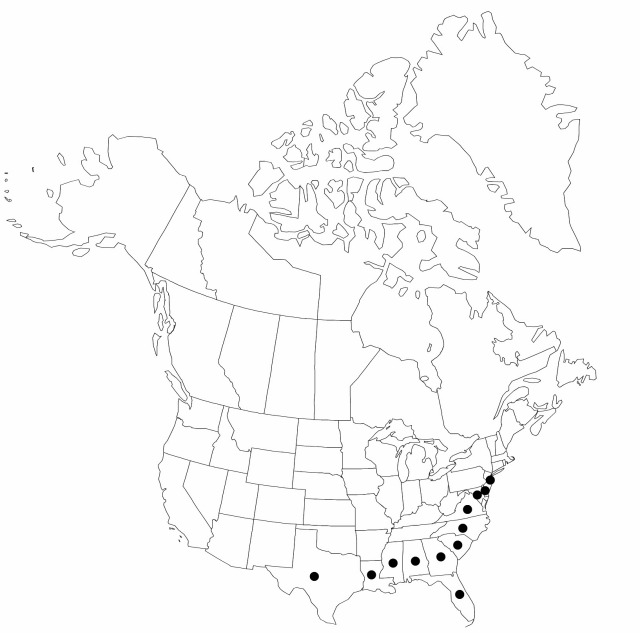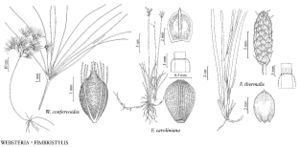Fimbristylis caroliniana
Rhodora 42: 246. 1940.
Plants perennial, to 150 (–200) cm, cespitose or not; rhizomes scaly, slender, elongate. Culms wandlike, at least 50 cm. Leaves nearly distichous, spreading to ascending, 1/2 length of culms, sheath margins ciliolate at junction with blade, backs smooth to pubescent; ligule present, usually complete; blades linear, 2–5 mm wide, flat to involute, margins scabridulous, surfaces mostly glabrous. Inflorescences: anthelae compound, dense or diffuse, mostly longer than broad; scapes wandlike, broadly linear, distally usually compressed, marginal ribs scabrid distally; longest primary involucral-bract exceeding or shorter than anthela. Spikelets pale-brown or redbrown, broadly ovoid, ellipsoid, or lanceoloid, 5–15 mm; fertile scales ovate, 3–4 mm, apex rounded, often puberulent distally, midrib excurrent as scabrid mucro or short cusp. Flowers: stamens 3; styles 2-fid, flat, fimbriolate. Achenes pale to deep brown, lenticular-obovoid, 1 mm, finely but definitely cancellate with 14–15 horizontally oriented lattices per side. 2n = 20, 30, 60.
Phenology: Fruiting summer–fall.
Habitat: Sands or sandy peats of slightly brackish to circumneutral marsh, interdunal swales and low sandy areas near coast
Elevation: 0–100 m
Distribution

Ala., Del., Fla., Ga., La., Md., Miss., N.J., N.C., S.C., Tex., Va., Mexico, West Indies
Discussion
The tallest, coarsest plants of Fimbristylis caroliniana, formerly referred to as F. harperi Britton ex Small, are the most clonal of North American Fimbristyloids, some clones literally covering acres of sandy swale or beach.
Selected References
None.
Lower Taxa
"shortened" is not a number."/2lengthofculms" is not declared as a valid unit of measurement for this property.
